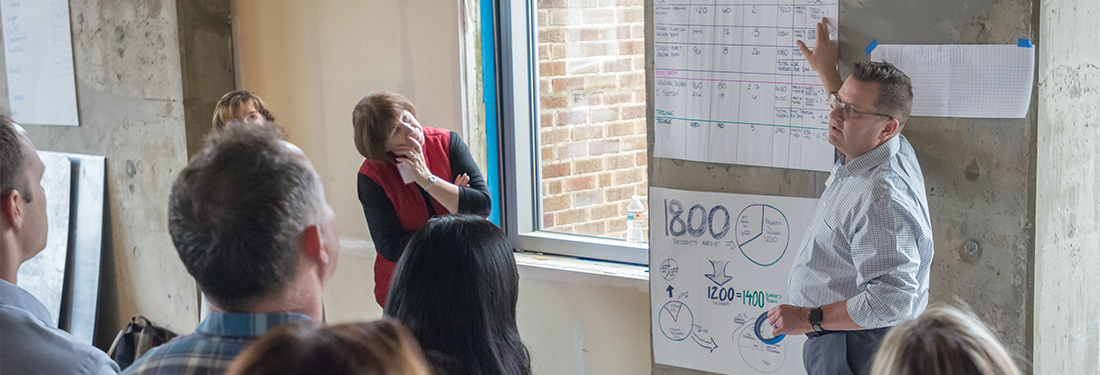What Is Lean Healthcare?
Applying Lean to healthcare
The concept of Lean management is often misunderstood when it’s applied to healthcare. For example, some see Lean as a euphemism for cutting costs. But that’s far from the truth.
Lean in healthcare is about creating value and reducing burdens that patients and staff experience every day. So rather than focusing on saving money, Lean organizations focus on sustaining high levels of quality, safety, satisfaction and morale. They do this by aligning the entire workforce around a consistent management system and using that system to promote, test and implement process improvements on an ongoing basis.
Although cost savings aren’t the focus of Lean management, they are often an outcome. After all, redesigning tasks and workflows to improve care usually means saving time and other resources. It can have other benefits as well, such as helping workers feel more empowered and engaged and reducing their sources of burnout.
In the end, terms like Lean, Six Sigma, and other labels that get attached to quality-improvement concepts are less important than the concepts and strategies they represent. These concepts and strategies have been tested and proven in countless industries. In healthcare, they have tremendous potential to help organizations keep patients safe and satisfied, support and inspire staff at all levels, and sustain their success for the long term.
Lean healthcare isn’t …
As healthcare experts who work alongside our partners to build their self-sufficiency, we regularly hear, “Isn’t Lean about cost-cutting? Won’t that harm patient care?”
Those questions come from the right motivation. But Lean healthcare is not about cutting costs. In many cases, yes, the changes you make by following Lean principles help your bottom line — but a patient-centered management system isn’t implemented with the aim of reducing costs.
Lean healthcare is …
As mentioned above, Lean is about putting the patient first. A Lean management system encompasses a range of big-picture characteristics and day-to-day practices, which take time to fully implement.
At a high level, we can define a Lean organization by a handful of core activities and principles:
Implementing processes that add value from a patient perspective — and eliminating or improving those that don’t
In healthcare, success is defined by patient outcomes and experience. Lean healthcare organizations define every employee’s work by the same standards.
To do that, it’s necessary to walk in the patient’s shoes. For example, a team might explore the steps their patients go through each time they come in to see a provider. This helps the team identify and remove roadblocks for patients, such as:
- Waiting for services, providers or answers
- Traveling across the facility to find ancillary services
- Filling out paperwork in person instead of online ahead of time
Improving wait time doesn’t necessarily reduce costs, but it has other worthwhile benefits. A patient who completes paperwork at home may be more likely to arrive on time, which helps all patients receive the timely care they expect. The patient may also be more thorough and accurate when entering information about current medications, which helps providers make informed treatment decisions and avoid harmful drug interactions.
Aligning leaders and staff around a shared vision
Lean management mobilizes the entire workforce to improve the work that matters most to the organization. Leaders set clear goals, while teams and even individual team members adopt their own targets that support those goals. For example, if an organization aims to reduce central line infections by 80%, then all teams who handle central lines subscribe to the same goal, iterating on solutions and tracking progress.
This alignment does more than drive results for the organization’s priorities. It also improves staff satisfaction and engagement, by inviting them to be vital and valued contributors to the organization’s mission and success.
Promoting a culture of continuous improvement
Quality and safety can never be “reached.” They must be sustained. A Lean healthcare organization provides the structure and culture that workers need to sustain quality and safety as part of their daily work.
This runs counter to the practice of quality “initiatives,” where the job of improving quality falls to a dedicated team or office, often for a specific amount of time. How can one team affect quality throughout an organization? And what happens when the initiative is done?
Lean organizations don’t need to worry about these questions, because every team works on improving quality, every single day.
Empowering frontline staff to drive improvement efforts
Constant improvement is possible only when frontline workers are empowered to lead it. A central tenet of Lean is respecting the expertise of the individuals who do the work.
Leaders show respect by stepping away from the role of problem-solver and instead take on the role of problem-framer. In healthcare, this means leaders:
- Physically go to the place where the frontline staff deliver care to patients every day
- See what team members are doing and ask thoughtful questions about the rationale of processes
- Empower team members to drive improvements
In the role of problem framers, leaders give frontline team members the time and tools to find inefficiencies and then devise and implement new, more effective methods. Ultimately, the entire team is engaged and valued, and both patient care and team satisfaction improve.
Finding the root cause of pain points and inefficiencies
A key habit in the practice of constant improvement is root cause analysis: going beyond factors on the surface to find the true source of a problem. Root causes are often mundane, such as where equipment is stored or how samples are labeled. But these mundane factors can lead to annoying or even harmful outcomes and errors. So adjusting them can make work significantly safer and more efficient.
Seeking root causes is another way of showing respect for workers. Rather than blame the person who made a mistake, leaders partner with the person to explore why the error was made. What conditions allowed the mistake to occur? How can we change them to prevent future mistakes and promote the safe, high-quality actions we want? By focusing on why the process — and not the person — may be flawed, leaders cultivate an environment where frontline staff are more eager and willing to speak up and share their ideas for improvement.
Flexibility and willingness to change
Patient care is inherently dynamic. Lean organizations, like any other, will often try solutions that don’t end up working as intended. This proves that the willingness to try new solutions is even more important than the initial impulse to improve.
With quality improvement, strategic alignment, staff empowerment and other core competencies baked into their DNA and daily operation, Lean organizations have the tools and mindset to iterate, flex, evolve and innovate.
Lean in action: Real results
A patient-centered system can be a powerful management method for healthcare organizations. It can promote better stewardship of resources and provide improved care to patients, faster and more affordably.
Lean management practices have helped numerous organizations achieve these and other benefits, such as:
- Sustained improvements in patient safety: The University of Maryland St. Joseph Medical Center (UM SJMC) partnered with Virginia Mason Institute to develop and mobilize a single management system designed for everyone in the organization. Three years after launch, UM SJMC succeeded in cutting its annual harm incidents in half, as well as surpassing its targets for raising patient experience ratings and reducing employee injuries. Improvements like these helped St. Joseph earn numerous accolades, including a five-star rating from the Centers for Medicare and Medicaid Services, an A grade for safety from Leapfrog, and recognition from U.S. News and World Report as the top community hospital in Maryland.
- Optimized patient flow in primary care: The Virginia Mason Institute helped WakeMed Health and Hospitals improve ambulatory flow in its primary care clinics. Teams used Lean techniques such as aligning around a shared vision and forming 5S agreements, a method of improving safety and organization. The improvements they made kept patients on schedule and accommodated walk-ins and allowed staff to take a full lunch hour and go home on time with all work complete.
- Reduced surgical setup to improve patient outcomes: A Virginia Mason team overseeing surgical instrument setup used root cause analysis to reduce errors, dramatically lessen prep time, and minimize the need for instrument storage. As a result of the changes, surgeons could perform more procedures, better meeting patients’ needs.
Learn more
Ready to learn more?
- Download a self-assessment tool to identify strengths and opportunities to support a culture of improvement at your organization.
- Download a case study about our partner using Lean strategies to pursue patient safety and other goals.
- Explore trainings, including an introductory flow improvement virtual training and intensive process improvement virtual training.





